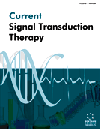- Home
- A-Z Publications
- Current Signal Transduction Therapy
- Previous Issues
- Volume 5, Issue 1, 2010
Current Signal Transduction Therapy - Volume 5, Issue 1, 2010
Volume 5, Issue 1, 2010
-
-
Preface
More LessAuthors: Gyorgy Keri and Axel UllrichThe journal Current Signal Transduction Therapy will start its 5th year in 2010 and in the past four years it has covered a very broad spectrum of the signaling- related molecular pathomechanisms and the existing and potential therapeutic possibilities. The journal has been very well received by the scientific community as it has generated an impact in three years and it is acknowledged and cited in many scientific publications Read More
-
-
-
Editorial [Hot topic: Therapeutic Potential of O-GlcNAc Glycosylation Related Signaling Pathways (Guest Editor: Prof. Dr. Brigitte Schmitz)]
More LessIt appears to be now fairly well accepted in the field of signal transduction that the monosaccharide N-acetylglucosamine (O-GlcNAc) added posttranslationally through a β-O-glycosidic linkage to serine and threonine residues in cytosolic and nuclear proteins has important regulatory roles. Since its first description in 1984 until today this highly dynamic sugar has been shown to be attached to about thousand proteins. Read More
-
-
-
Metabolic Regulation by the Hexosamine Biosynthesis/O-Linked N-Acetyl Glucosamine Pathway
More LessAuthors: Donald A. McClain, Rodrick P. Taylor, Yudi Soesanto and Bai LuoModification of cytosolic, nuclear, and mitochondrial proteins on serine and threonine residues by Nacetylglucosamine (O-GlcNAc) provides a mechanism by which glucose flux rates in the cell can feed back to regulate the function and synthesis of proteins involved in metabolism and growth. The hexosamine biosynthesis pathway (HBP) provides the substrate for this modification, UDP-GlcNAc. Production of UDP-GlcNA Read More
-
-
-
The Role of the O-GlcNAc Modification in Regulating Eukaryotic Gene Expression
More LessAuthors: Sandii Brimble, Edith E. Wollaston-Hayden, Chin F. Teo, Andrew C. Morris and Lance WellsO-linked a-N-acetylglucosamine (O-GlcNAc) modification of proteins has been shown to be involved in many different cellular processes, such as cell cycle control, nutrient sensing, signal transduction, stress response and transcriptional regulation. Cells have developed complex regulatory systems in order to regulate gene expression appropriately in response to environmental and intracellular cues. Control of eukaryotic ge Read More
-
-
-
Dynamic Crosstalk between GlcNAcylation and Phosphorylation: Roles in Signaling, Transcription and Human Disease (Supplementary Material)
More LessAuthors: Shino Shimoji, Kyoungsook Park and Gerald W. HartGlcNAcylation is a dynamic cytoplasmic and nuclear post-translational sugar modification of serine/threonine residues. The addition and removal of O-GlcNAc are regulated by O-GlcNAc Transferase and O-GlcNAcase, respectively. Over ∼1000 proteins have been identified to be GlcNAcylated with over 240 mapped sites. O-GlcNAc is involved in critical cellular functions, such as cell-cycle regulation, apoptosis, stress responses, Read More
-
-
-
Immune Regulation by the Posttranslational Modification O-GlcNAc
More LessAuthors: Alexander Pappa and Danilo GueriniThe posttranslational modification of proteins by a single O-linked N-acetylglucosamine (O-GlcNAc) is an intracellular biochemical reaction which is ubiquitous in eukaryotic cells. Two enzymes regulate the process: O-linked Nacetylglucosaminyltransferase (OGT), which attaches O-GlcNAc to serine/threonine residues of proteins, and a a-Nacetylglucosaminidase (O-GlcNAcase), that removes the O-GlcNAc group. The serine or Read More
-
-
-
Protein O-GlcNAcylation: A Critical Regulator of the Cellular Response to Stress
More LessAuthors: John C. Chatham and Richard B. MarchaseThe post-translational modification of serine and threonine residues of nuclear and cytoplasmic proteins by the O-linked attachment of the monosaccharide ß-N-acetyl-glucosamine (O-GlcNAc) is a highly dynamic and ubiquitous protein modification that plays a critical role in regulating numerous biological processes. Much of our understanding of the mechanisms underlying the role of O-GlcNAc on cellular function has Read More
-
-
-
C. elegans Genetic Networks Predict Roles for O-GlcNAc Cycling in Key Signaling Pathways
More LessAuthors: Michelle A. Mondoux, Michael W. Krause and John A. HanoverCaenorhabditis elegans is perhaps the best-understood metazoan in terms of cell fate, neural connectivity, nutrient sensing, and longevity. The study of this genetically amenable model has greatly accelerated progress in understanding human aging-associated diseases, such as diabetes and neurodegeneration. The nutrient-responsive cycling of OGlcNAc on key intracellular targets may play a key, yet unappreciated, role Read More
-
-
-
Mechanism, Structure, and Inhibition of O-GlcNAc Processing Enzymes
More LessAuthors: Tracey M. Gloster and David J. VocadloThe post-translational modification of nucleocytoplasmic proteins with O-linked 2-acetamido-2-deoxy-Dglucopyranose (O-GlcNAc) is a topic of considerable interest and attracts a great deal of research effort. O-GlcNAcylation is a dynamic process which can occur multiple times over the lifetime of a protein, sometimes in a reciprocal relationship with phosphorylation. Several hundred proteins, which are involved in a dive Read More
-
Volumes & issues
-
Volume 20 (2025)
-
Volume 19 (2024)
-
Volume 18 (2023)
-
Volume 17 (2022)
-
Volume 16 (2021)
-
Volume 15 (2020)
-
Volume 14 (2019)
-
Volume 13 (2018)
-
Volume 12 (2017)
-
Volume 11 (2016)
-
Volume 10 (2015)
-
Volume 9 (2014)
-
Volume 8 (2013)
-
Volume 7 (2012)
-
Volume 6 (2011)
-
Volume 5 (2010)
-
Volume 4 (2009)
-
Volume 3 (2008)
-
Volume 2 (2007)
-
Volume 1 (2006)
Most Read This Month
Article
content/journals/cst
Journal
10
5
false
en


